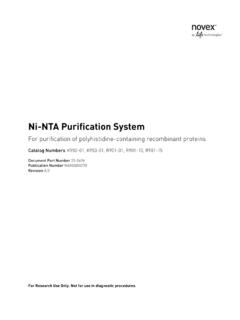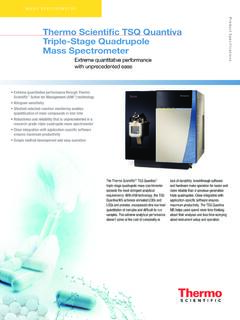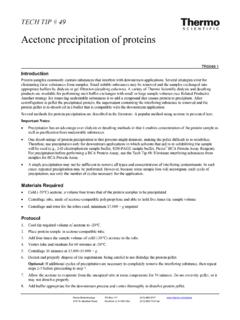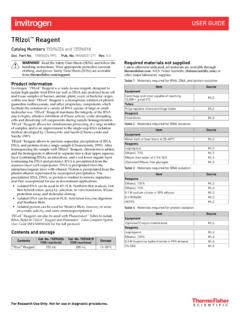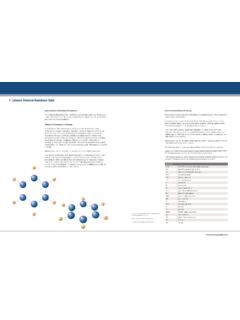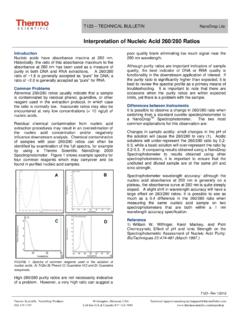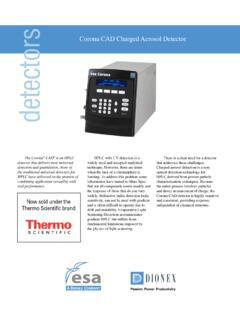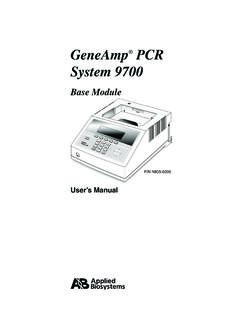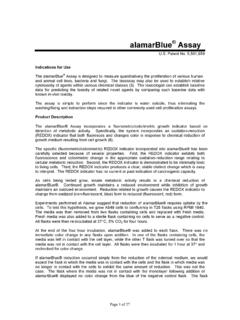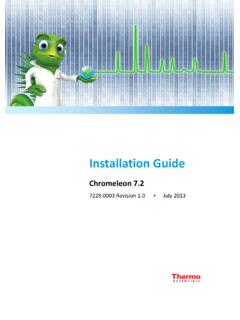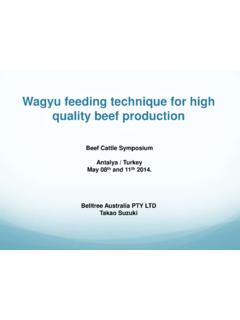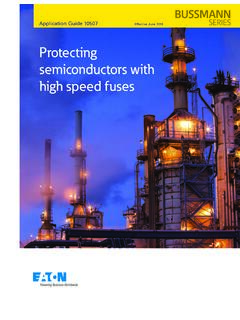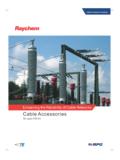Transcription of Pichia Fermentation Process Guidelines Overview
1 Version B 053002 Pichia Fermentation Process Guidelines Overview Introduction Pichia pastoris, like Saccharomyces cerevisiae, is particularly well-suited for fermentative growth. Pichia has the ability to reach very high cell densities during Fermentation which may improve overall protein yields. We recommend that only those with Fermentation experience or those who have access to people with experience attempt Fermentation . Since there are a wide variety of fermenters available, it is difficult to provide exact procedures for your particular case. The Guidelines given below are based on fermentations of both Mut+ and MutS Pichia strains in a 15 liter table-top glass fermenter.
2 Please read the operator's manual for your particular fermenter before beginning. The table below provides an Overview of the material covered in these Guidelines . Step Topic Page 1 Fermentation parameters 1 2 Equipment needed and preparation of medium 2 3 Measurement and use of dissolved oxygen (DO) in the culture 3 4 Growth of the inoculum 4 5 Generation of biomass on glycerol in batch and fed-batch phases 4-5 6 Induction of expression of Mut+ and MutS recombinants in the methanol fed-batch phase 6-7 7 Harvesting and lysis of cells 8 8 References 9-10 9 Recipes 11 Fermentation Parameters It is important to monitor and control the following parameters throughout the Fermentation Process .
3 The following table describes the parameters and the reasons for monitoring them. Parameter Reason Temperature ( C) Growth above 32 C is detrimental to protein expression Dissolved oxygen (>20%) Pichia needs oxygen to metabolize glycerol and methanol pH ( and ) Important when secreting protein into the medium and for optimal growth Agitation (500 to 1500 rpm) Maximizes oxygen concentration in the medium Aeration ( to vvm* for glass fermenters) Maximizes oxygen concentration in the medium which depends on the vessel Antifoam (the minimum needed to eliminate foam)
4 Excess foam may cause denaturation of your secreted protein and it also reduces headspace Carbon source (variable rate) Must be able to add different carbon sources at different rates during the course of Fermentation * volume of oxygen (liters) per volume of Fermentation culture (liters) per minute continued on next page 2 Overview , continued Recommended Equipment Below is a checklist for equipment recommendations. A jacketed vessel is needed for cooling the yeast during Fermentation , especially during methanol induction. You will need a constant source of cold water (5-10 C). This requirement may mean that you need a refrigeration unit to keep the water cold.
5 A foam probe is highly recommended as antifoam is required. A source of O2--either air (stainless steel fermenters at 1-2 vvm) or pure O2 ( vvm for glass fermenters). Calibrated peristaltic pumps to feed the glycerol and methanol. Automatic control of pH. Medium Preparation You will need to prepare the appropriate amount of following solutions: Fermentation Basal Salts (page 11) PTM1 Trace Salts (page 11) ~75 ml per liter initial Fermentation volume of 50% glycerol containing 12 ml PTM1 Trace Salts per liter of glycerol. ~740 ml per liter initial Fermentation volume of 100% methanol containing 12 ml PTM1 Trace Salts per liter of methanol.
6 Monitoring the Growth of Pichia pastoris Cell growth is monitored at various time points by using the absorbance at 600 nm (OD600) and the wet cell weight. The metabolic rate of the culture is monitored by observing changes in the concentration of dissolved oxygen in response to carbon availability (see next page). 3 Dissolved Oxygen (DO) Measurement Introduction The dissolved oxygen concentration is the relative percent of oxygen in the medium where 100% is O2-saturated medium. Pichia will consume oxygen as it grows, reducing the dissolved oxygen content. However, because oxygen is required for the first step of methanol catabolism, it is important to maintain the dissolved oxygen (DO) concentra-tion at a certain level (>20%) to ensure growth of Pichia on methanol.
7 Accurate measurement and observation of the dissolved oxygen concentration of a culture will give you important information about the state and health of the culture. Therefore, it is important to accurately calibrate your equipment. Please refer to your operator's manual. Maintaining the Dissolved Oxygen Concentration (DO) 1. Maintaining the dissolved oxygen above 20% may be difficult depending on the oxygen transfer rates (OTR) of the fermenter, especially in small-scale glass vessels. In a glass vessel, oxygen is needed to keep the DO above 20%, usually ~ vvm (liters of O2 per liter of Fermentation culture per minute). Oxygen consumption varies and depends on the amount of methanol added and the protein being expressed.
8 2. Oxygen can be used at to vvm to achieve adequate levels. This can be accomplished by mixing with the air feed and can be done in any glass fermenter. For stainless steel vessels, pressure can be used to increase the OTR. Be sure to read the operator's manual for your particular fermenter. 3. If a fermenter cannot supply the necessary levels of oxygen, then the methanol feed should be scaled back accordingly. Note that decreasing the amount of methanol may reduce the level of protein expression. 4. To reach maximum expression levels, the Fermentation time can be increased to deliver similar levels of methanol at the lower feed rate. For many recombinant proteins, a direct correlation between amount of methanol consumed and the amount of protein produced has been observed.
9 Use of DO Measurements During growth, the culture consumes oxygen, keeping the DO concentration low. Note that oxygen is consumed whether the culture is grown on glycerol or methanol. The DO concentration can be manipulated to evaluate the metabolic rate of the culture and whether the carbon source is limiting. The metabolic rate indicates how healthy the culture is. Determining whether the carbon source is limiting is important if you wish to fully induce the AOX1 promoter. For example, changes in the DO concentrations (DO spikes) allow you to determine whether all the glycerol is consumed from the culture before adding methanol. Secondly, it ensures that your methanol feed does not exceed the rate of consumption.
10 Excess methanol (> 1-2% v/v) may be toxic. Manipulation of DO If carbon is limiting, shutting off the carbon source should cause the culture to decrease its metabolic rate, and the DO to rise (spike). Terminate the carbon feed and time how long it takes for the DO to rise 10%, after which the carbon feed is turned back on. If the lag time is short (< 1 minute), the carbon source is limiting. 4 Fermenter Preparation and Glycerol Batch Phase Inoculum Seed Flask Preparation Remember not to put too much medium in the baffled flasks. Volume should be 10-30% of the total flask volume. 1. Baffled flasks containing a total of 5-10% of the initial Fermentation volume of MGY or BMGY are inoculated with a colony from a MD or MGY plate or from a frozen glycerol stock.
